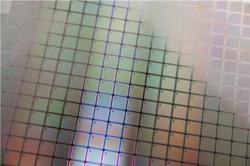Mar 24 2010
Researchers at Vienna University of Technology's Institute of Atomic and Subatomic Physics are really happy about the accreditation of their X-ray laboratory, which is the only one of its type in Austria.
 Surface of a wafer
Surface of a wafer
Here, silicon substrate plates ("wafers") are examined under clean-room conditions with a non-destructive analysis methods.
At the Institute of Atomic and Subatomic Physics's newly accredited X-ray laboratory, intensive X-ray beams are used to examine the surfaces of silicon wafers for inorganic contamination by elements ranging from potassium (K) to lead (Pb) by means of TXRF (Total-Reflection X-ray Fluorescence Analysis). Using a fully automatic robot system, the objects to be examined (with a maximum diameter of 200 mm) are loaded into the spectrometer, irradiated, and the resulting characteristic radiation of the elements is measured. This method, unique in Austria, allows an extremely sensitive determination in the ultra-trace range of up to 1010 atoms per cm2. "It's difficult to imagine how small the quantities are that we can detect here in the lab", explains Laboratory Supervisor, Prof. Christina Streli. For comparison: Even with a single fingerprint, a person leaves more matter on the surface than the amount which can be detected here.
The research work at the Stadionallee laboratory in the Vienna Prater is of particular interest to the semiconductor industry. Silicon wafers are round, 0.5 mm thick discs with a diameter of up to 400 mm. These are used as a substrate for electronic or micromechanical components. In order to improve the quality, function and service life of these semiconductor elements, as well as to reduce costs, the determination and analysis of contamination with atoms of other substances is extremely important.
Certified
The accredited Atomika 8030W which is used in the laboratory according to accreditation Standard ISO 17025 is the pride and joy of the research team. The laboratory's Quality Manager, Dr. Peter Kregsamer has supervised the work-intensive, three year accreditation process and reports: "The extensive documentation, the consideration of all the imposed conditions and the coordination of the assessments took time, but our success made it all worthwhile." The Austrian Federal Ministry of Economy, Family and Youth sent through the accreditation notification last week.
Students involved from the very start.
The involvement of students in the research projects is an important aspect of the work in the X-ray laboratory. At present, two students (one taking a diploma and one writing a dissertation) are supporting the scientists as "Process technicians in training" as part of their Physics courses. Through this, they will supplement their skills in quality management, assurance, control and improvement.
ANNA connects researchers through "Golden labs"
The Institute of Atomic and Subatomic Physics is an active partner of ANNA (Analytical Network for Nanotechnology). This EU project promotes cooperation in micro and nanotechnology between independent laboratories. It improves the availability of an analytical infrastructure. "As part of ANNA, we make our laboratory available to foreign applicants free of charge. The
transnational access increases the development of multi-site laboratories and of course the facilities of our foreign partners are also of interest to staff at TU Vienna", explains Christina Streli. In the form of "Golden laboratories", accredited, independent laboratories will be grouped to form a network for the collaboration and synergy of analytical scientists and institutions. Throughout the world, an enormous amount of research and development effort in the field of micro and nanoelectronics is being focused on the understanding and control of the properties of matter at atomic dimensions.
Source: http://www.tuwien.ac.at/tuwien_home/EN/